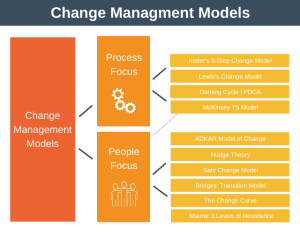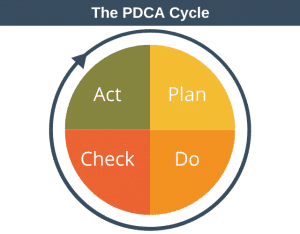Change Management
Change Management is the process of moving an organization from its current state to a desired future state.
Organizations need to change for any number of reasons. They may want to improve performance, chase opportunities, or respond to a competitor, amongst others.
What is Change Management?”
Change Management is the process by which we prepare for change, manage the transition, and then monitor the new ways of working. At all times it is important to ensure that the change remains viable and results in positive outcomes for the organization.
Each organization is unique, and the change it undergoes will also be unique. However, Change Management provides us with a set of tools and best practice we can use to move the organization from its current state to its desired future state.
It is important to realize that Change Management isn’t just the process of managing the change itself. There are actually several levels of any organizational change.
Level 1: Individual Change
Ultimately, all change happens at the individual level. So this level focuses on tools which help us to understand how people react to change that is imposed on them by others.
People often feel very threatened by change. It’s impossible to simply flick a switch and suddenly these people will be engaged in the change.
The models in this level help leaders understand the emotions people experience when faced with a change. Leaders can then use these models to help guide their teams through the transition as efficiently as they can.
Models you can use to guide individual change include:
- Scott & Jaffe’s Change Model.
- Kotter & Schlesinger Approaches for overcoming resistance to change.
- The ADKAR Change Model.
- The Change Curve.
Level 2: Change Management Processes
The second level of Change Management focuses on how leaders can make change happen.
This is about planning for the change and then implementing the change. It’s about making the change actually happen. It’s execution.
Models you can use to make change happen include:
- Kotter’s Model to Lead Change.
- Contingency Planning.
- The Model Office.
- Deming’s 14 Points to Transform a Business.
- The Deming Cycle
Level 3: Enterprise Change
The final level of Change Management occurs at the enterprise level. This is the level of the CEO and the executive board.
This level is about ensuring that your organization is set up in such a way that it can respond and thrive in an ever-changing world.
In short, this level is about strategy.
We can an entire section of this website dedicated to business strategy where you can learn everything you need to know about strategy and strategic planning.
Related Skills
To successfully manage a complex organizational change you need a variety of different skills in addition to the tools described above. These skills include:






















